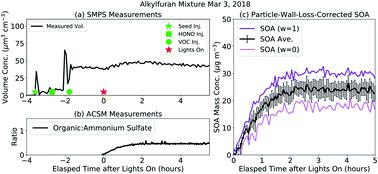当前位置:
X-MOL 学术
›
Environ. Sci.: Processes Impacts
›
论文详情
Our official English website, www.x-mol.net, welcomes your
feedback! (Note: you will need to create a separate account there.)
Secondary organic aerosol formation from evaporated biofuels: comparison to gasoline and correction for vapor wall losses.
Environmental Science: Processes & Impacts ( IF 4.3 ) Pub Date : 2020-06-19 , DOI: 10.1039/d0em00103a Yicong He 1 , Brandon King 1 , Matson Pothier 2 , Liam Lewane 1 , Ali Akherati 1 , James Mattila 2 , Delphine K Farmer 2 , Robert L McCormick 3 , Matthew Thornton 3 , Jeffrey R Pierce 4 , John Volckens 1 , Shantanu H Jathar 1
Environmental Science: Processes & Impacts ( IF 4.3 ) Pub Date : 2020-06-19 , DOI: 10.1039/d0em00103a Yicong He 1 , Brandon King 1 , Matson Pothier 2 , Liam Lewane 1 , Ali Akherati 1 , James Mattila 2 , Delphine K Farmer 2 , Robert L McCormick 3 , Matthew Thornton 3 , Jeffrey R Pierce 4 , John Volckens 1 , Shantanu H Jathar 1
Affiliation

|
With an ongoing interest in displacing petroleum-based sources of energy with biofuels, there is a need to measure and model the formation and composition of secondary organic aerosol (SOA) from organic compounds present in biofuels. We performed chamber experiments to study SOA formation from four recently identified biofuel molecules and mixtures and commercial gasoline under high NOx conditions: diisobutylene, cyclopentanone, an alkylfuran mixture, and an ethanol-to-hydrocarbon (ETH) mixture. Cyclopentanone and diisobutylene had a significantly lower potential to form SOA compared to commercial gasoline, with SOA mass yields lower than or equal to 0.2%. The alkylfuran mixture had an SOA mass yield (1.6%) roughly equal to that of gasoline (2.0%) but ETH had an average SOA mass yield (11.5%) that was six times higher than that of gasoline. We used a state-of-the-science model to parameterize or simulate the SOA formation in the chamber experiments while accounting for the influence of vapor wall losses. Simulations performed with vapor wall losses turned off and at atmospherically relevant conditions showed that the SOA mass yields were higher than those measured in the chamber at the same photochemical exposure and were also higher than those estimated using a volatility basis set that was fit to the chamber data. The modeled SOA mass yields were higher primarily because they were corrected for vapor wall losses to the Teflon® chamber.
中文翻译:

由蒸发的生物燃料形成的二次有机气溶胶:与汽油的比较和蒸气壁损失的校正。
随着用生物燃料代替石油基能源的持续兴趣,需要测量和模拟由生物燃料中存在的有机化合物形成的次级有机气溶胶(SOA)的组成和组成。我们进行了室实验研究从下高不三不四最近发现的生物燃料分子及其混合物和商用汽油SOA形成X条件:二异丁烯,环戊酮,烷基呋喃混合物和乙醇-碳氢化合物(ETH)混合物。与市售汽油相比,环戊酮和二异丁烯的形成SOA的潜力明显较低,SOA的质量收率低于或等于0.2%。烷基呋喃混合物的SOA质量产率(1.6%)大约等于汽油(2.0%),但ETH的平均SOA质量产率(11.5%)比汽油高六倍。我们在实验室实验中使用了科学模型来对SOA的形成进行参数化或模拟,同时考虑了蒸汽壁损失的影响。在关闭蒸气壁损失并在与大气有关的条件下进行的仿真表明,在相同光化学暴露下,SOA的质量产率高于在室中测量的结果,并且也高于使用适合室的挥发性基准集估算的结果。数据。建模后的SOA的质量产率较高,主要是因为已校正了对Teflon®腔室产生的蒸气壁损失的情况。
更新日期:2020-07-22
中文翻译:

由蒸发的生物燃料形成的二次有机气溶胶:与汽油的比较和蒸气壁损失的校正。
随着用生物燃料代替石油基能源的持续兴趣,需要测量和模拟由生物燃料中存在的有机化合物形成的次级有机气溶胶(SOA)的组成和组成。我们进行了室实验研究从下高不三不四最近发现的生物燃料分子及其混合物和商用汽油SOA形成X条件:二异丁烯,环戊酮,烷基呋喃混合物和乙醇-碳氢化合物(ETH)混合物。与市售汽油相比,环戊酮和二异丁烯的形成SOA的潜力明显较低,SOA的质量收率低于或等于0.2%。烷基呋喃混合物的SOA质量产率(1.6%)大约等于汽油(2.0%),但ETH的平均SOA质量产率(11.5%)比汽油高六倍。我们在实验室实验中使用了科学模型来对SOA的形成进行参数化或模拟,同时考虑了蒸汽壁损失的影响。在关闭蒸气壁损失并在与大气有关的条件下进行的仿真表明,在相同光化学暴露下,SOA的质量产率高于在室中测量的结果,并且也高于使用适合室的挥发性基准集估算的结果。数据。建模后的SOA的质量产率较高,主要是因为已校正了对Teflon®腔室产生的蒸气壁损失的情况。











































 京公网安备 11010802027423号
京公网安备 11010802027423号